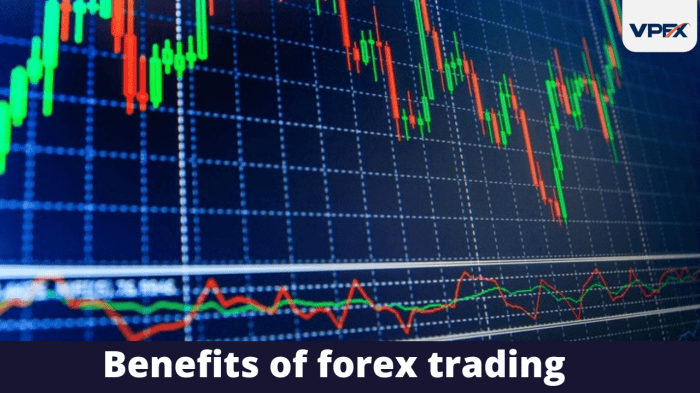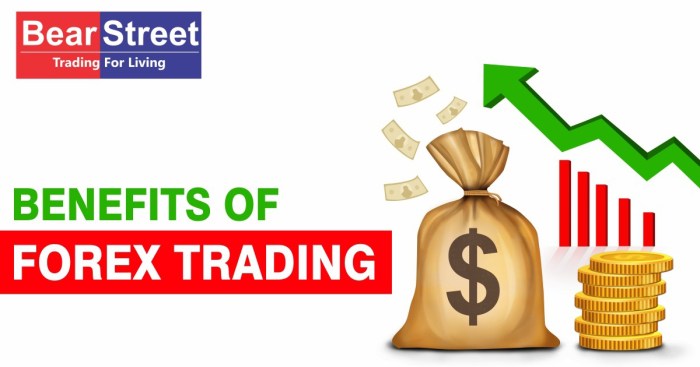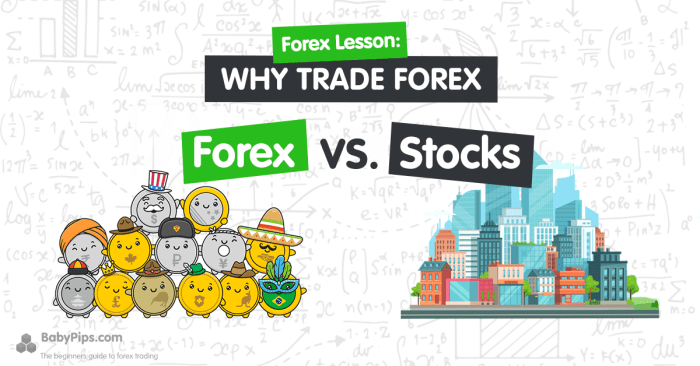
Benefits forex trading? Think beyond the hype. This isn’t just about get-rich-quick schemes; it’s about accessing a global market brimming with opportunity, offering unparalleled flexibility and the potential for significant returns. But let’s be real, it’s also a high-stakes game. We’ll delve into the lucrative possibilities, the inherent risks, and everything in between, equipping you with the knowledge to navigate this exciting world.
From understanding leverage and margin to mastering technical analysis, we’ll break down the complexities of forex trading in a way that’s both informative and engaging. We’ll explore how forex trading can fit into different lifestyles, compare it to other investment options, and even show you how to build a hypothetical portfolio to visualize your potential gains (or losses!). This isn’t your grandpa’s investment advice; this is a no-nonsense guide to understanding the benefits and challenges of forex trading in the 21st century.
Financial Benefits of Forex Trading

Forex trading, the global exchange of currencies, presents a unique opportunity for significant financial gains. Unlike traditional investments with limited growth potential, forex offers the possibility of high returns due to its 24/5 market accessibility and high leverage. However, it’s crucial to understand that this potential is coupled with substantial risk. This section will delve into the financial benefits, highlighting both the potential rewards and the influencing factors.
High Return Potential in Forex Trading
The forex market’s high liquidity and volatility create an environment where substantial profits can be realized in relatively short periods. Leverage, a key feature of forex trading, allows traders to control larger positions with a smaller initial investment. For instance, a 1:100 leverage allows a trader to control $100,000 with only $1,000 of their own capital. This magnification of returns can lead to significant profits, but equally significant losses if the market moves against the trader’s position. Successful traders carefully manage risk to capitalize on these opportunities while mitigating potential downsides.
Factors Influencing Forex Market Profitability
Several factors significantly impact profitability in forex trading. Market analysis, including fundamental (economic indicators, political events) and technical (chart patterns, indicators) analysis, is crucial for identifying profitable trading opportunities. Risk management techniques, such as stop-loss orders and position sizing, are essential for limiting potential losses. Trading psychology and discipline are equally important; emotional trading often leads to poor decisions. Finally, a trader’s understanding of global economic events and their impact on currency pairs is key to making informed decisions. A deep understanding of these factors is crucial for consistent profitability.
Comparison of Forex Returns with Other Investment Options
Compared to traditional investments like stocks and bonds, forex trading offers the potential for higher returns but also carries significantly higher risk. Stocks and bonds generally offer steadier, albeit slower, growth. Forex trading, on the other hand, can yield much faster returns but also exposes traders to the possibility of substantial losses. Real estate investment offers potential for long-term capital appreciation and rental income, but liquidity is lower compared to forex. The choice between these options depends heavily on an individual’s risk tolerance and investment goals.
Examples of Successful Forex Trading Strategies
Several successful forex trading strategies exist, each with its own risk profile and return potential. Scalping, a short-term strategy focusing on small price movements, can generate frequent, small profits. Day trading involves holding positions for a single trading day, aiming to capitalize on intraday price fluctuations. Swing trading focuses on medium-term price movements, holding positions for several days or weeks. Each strategy requires a different level of expertise and time commitment, and their success depends on factors like market conditions and the trader’s skill. For example, a successful scalping strategy might aim for 10-20 pips profit per trade, accumulating significant gains over many trades. A swing trading strategy might aim for larger gains (50-100 pips or more) but with fewer trades.
Hypothetical Forex Trading Portfolio Performance
The following table illustrates a hypothetical portfolio’s performance over five years. It’s crucial to remember that this is a hypothetical example and actual results may vary significantly. Forex trading involves substantial risk, and losses are possible.
| Year | Initial Investment | Profit | Total Value |
|---|---|---|---|
| 1 | $10,000 | $2,000 | $12,000 |
| 2 | $12,000 | $1,500 | $13,500 |
| 3 | $13,500 | $2,500 | $16,000 |
| 4 | $16,000 | $3,000 | $19,000 |
| 5 | $19,000 | $2,800 | $21,800 |
Accessibility and Flexibility of Forex Trading

Forex trading, unlike many traditional investment avenues, boasts unparalleled accessibility and flexibility. Its decentralized nature and 24/5 availability make it a uniquely adaptable market, catering to a wide range of individuals regardless of their background, location, or schedule. This accessibility extends to both the types of investors involved and the sheer flexibility in how they can participate.
Forex trading’s accessibility stems from its low barrier to entry. Unlike stock markets that might require significant capital to start, forex trading accounts can often be opened with relatively small deposits. This opens the door to a broader range of participants, from individual retail traders to institutional investors. The global nature of the market means geographical limitations are minimal; traders can participate from virtually anywhere with an internet connection. This democratizing effect has significantly broadened the appeal of forex trading in recent years.
Accessibility to Different Investor Types
The forex market welcomes a diverse range of participants. Retail traders, often individuals trading with their own capital, make up a significant portion. These individuals can leverage leverage to amplify their potential returns (though this also increases risk). On the other hand, institutional investors, such as hedge funds and banks, participate on a much larger scale, influencing market trends with their significant trading volumes. The market also accommodates proprietary trading desks within financial institutions, employing specialized traders to manage the firm’s forex positions. This diverse participation ensures liquidity and contributes to the market’s vibrancy.
Flexibility in Trading Hours and Asset Choices
The forex market operates 24 hours a day, five days a week, spanning across multiple global time zones. This continuous trading allows traders to participate at times convenient to their schedules. A trader in New York can actively trade during the American trading session, while a trader in Tokyo can capitalize on the Asian session. This constant activity means opportunities are always present, regardless of geographical location or personal commitments. Furthermore, the forex market offers a wide range of currency pairs to trade, providing diversification options and allowing traders to tailor their strategies based on specific market dynamics.
Forex Trading and Various Lifestyles
Forex trading can seamlessly integrate into various lifestyles. A full-time trader might dedicate their entire day to market analysis and trading. Conversely, a part-time trader, perhaps holding a traditional job, can engage in forex trading during evenings or weekends, fitting it around their existing commitments. Even those with irregular schedules can find opportunities within the forex market’s 24/5 availability. The flexibility inherent in forex trading allows individuals to tailor their trading activity to their personal circumstances. For example, a stay-at-home parent might allocate specific time slots during the day to monitor the market and execute trades.
Comparison of Forex Trading Requirements with Other Markets
Compared to stock or futures markets, forex trading generally has lower initial capital requirements. While stock trading often involves purchasing whole shares, forex trading allows for smaller lot sizes, making it accessible to traders with limited funds. Futures contracts also typically require larger margins. However, it’s important to note that while the initial investment might be lower, forex trading carries significant risk due to leverage. The leverage available in forex can amplify both profits and losses, requiring careful risk management.
Opening a Forex Trading Account: A Step-by-Step Guide
Opening a forex trading account is a relatively straightforward process.
- Research and Select a Broker: Choose a reputable and regulated forex broker. Consider factors like fees, platform features, and customer support.
- Complete the Application: Fill out the application form, providing accurate personal and financial information.
- Verify Your Identity: The broker will require verification of your identity and address through documents such as a passport or driver’s license and utility bill.
- Fund Your Account: Deposit funds into your trading account using one of the broker’s accepted payment methods.
- Download and Install Trading Platform: Download and install the trading platform provided by your broker. Familiarize yourself with its features and functionalities.
- Start Trading (After Practice): Before committing real capital, it’s crucial to practice on a demo account to gain experience and refine your trading strategy.
Risks and Challenges of Forex Trading
Forex trading, while offering the potential for substantial profits, is inherently risky. The market’s volatility and the use of leverage can amplify both gains and losses, making it crucial for traders to understand and manage these risks effectively. Ignoring these inherent dangers can lead to significant financial setbacks.
Leverage and Volatility
Leverage allows traders to control larger positions than their capital would normally allow. While this magnifies potential profits, it equally magnifies potential losses. A small adverse price movement can wipe out a trader’s entire account if leverage is used improperly. Volatility, the degree of price fluctuation, further exacerbates this risk. High volatility periods, often triggered by geopolitical events or economic announcements, can lead to rapid and unpredictable price swings, making it challenging to manage trades effectively and potentially resulting in substantial losses. For instance, a trader using high leverage during a sudden market crash could see their account balance plummet in a matter of minutes.
Impact of Market Fluctuations
Market fluctuations are a constant in forex trading. These fluctuations are influenced by a multitude of factors including economic data releases (like inflation figures or interest rate decisions), political events (elections, wars, or policy changes), and global sentiment. Unexpected news or shifts in market sentiment can trigger sharp price movements, impacting open trades and potentially causing significant losses. For example, the unexpected Brexit vote in 2016 caused significant volatility in the GBP/USD pair, leading to substantial losses for many traders who were unprepared for such a dramatic shift.
Risk Management Strategies
Effective risk management is paramount in forex trading. This involves employing strategies to limit potential losses and protect capital. Key strategies include using stop-loss orders (automatically closing a trade when the price reaches a predetermined level), diversifying trades across multiple currency pairs to reduce the impact of any single pair’s volatility, and employing position sizing techniques (limiting the amount of capital allocated to each trade) to avoid overexposure. Additionally, thorough market analysis, understanding technical indicators, and utilizing fundamental analysis can help traders make more informed decisions and minimize risks.
Examples of Significant Losses
Numerous instances exist where forex traders have experienced substantial losses. In some cases, inexperienced traders, lured by the promise of quick riches, have leveraged excessively, resulting in the complete depletion of their trading accounts. Others have suffered significant losses due to a lack of understanding of market dynamics and the failure to utilize appropriate risk management techniques. The lack of a well-defined trading plan, combined with emotional trading decisions, frequently exacerbates these losses. One real-world example might involve a trader who invested their life savings in a single, highly leveraged trade based on a hunch, only to lose everything when the market moved against them.
Common Forex Trading Mistakes and Consequences
Understanding common forex trading mistakes is crucial for avoiding significant losses.
- Overleveraging: Using excessive leverage amplifies both profits and losses, potentially leading to account liquidation.
- Ignoring Risk Management: Failing to implement stop-loss orders or position sizing strategies leaves traders vulnerable to substantial losses.
- Emotional Trading: Making impulsive decisions based on fear or greed often leads to poor trading choices and increased losses.
- Lack of a Trading Plan: Trading without a well-defined strategy increases the likelihood of inconsistent results and losses.
- Insufficient Market Research: Failing to adequately analyze market trends and conditions can lead to uninformed trading decisions and losses.
- Chasing Losses: Attempting to recoup losses quickly by taking excessive risks often results in further losses.
Educational Resources and Skill Development
Forex trading, while potentially lucrative, demands a solid educational foundation. Success isn’t a matter of luck; it’s a direct result of acquiring the right knowledge and honing crucial skills. This section explores the available learning resources, the importance of analytical techniques, essential skills, chart interpretation, and a structured curriculum for forex education.
Available Educational Resources
Numerous resources cater to aspiring forex traders, ranging from beginner-friendly guides to advanced analytical tools. Books like “Japanese Candlestick Charting Techniques” by Steve Nison provide a deep dive into technical analysis, while online courses on platforms such as Udemy and Coursera offer structured learning paths covering fundamental and technical analysis, risk management, and trading psychology. Many reputable brokers also provide educational materials, webinars, and even demo accounts to allow practice in a risk-free environment. Furthermore, online communities and forums offer a space for peer-to-peer learning and sharing of experiences.
Fundamental and Technical Analysis in Forex Trading
Fundamental analysis focuses on macroeconomic factors influencing currency values. This includes examining economic indicators like GDP growth, inflation rates, interest rates, and government policies. A strong understanding of these factors allows traders to predict potential currency movements based on economic fundamentals. Conversely, technical analysis uses historical price and volume data to identify patterns and trends. This involves studying charts, using indicators like moving averages and RSI, and identifying support and resistance levels to predict future price movements. Successful forex trading often involves integrating both fundamental and technical analysis for a comprehensive approach.
Essential Skills for Successful Forex Trading
Proficiency in forex trading necessitates a diverse skillset. Risk management is paramount, involving techniques like position sizing, stop-loss orders, and diversification to limit potential losses. Effective market analysis, incorporating both fundamental and technical perspectives, is crucial for identifying profitable trading opportunities. Discipline is equally vital; sticking to a trading plan, avoiding emotional decisions, and managing risk consistently are key to long-term success. Adaptability is also important, as market conditions are constantly changing, requiring traders to adjust their strategies accordingly.
Interpreting Common Forex Trading Charts and Indicators
Forex charts typically display currency pairs’ price movements over time. Common chart types include candlestick charts, bar charts, and line charts. Candlesticks, for example, visually represent the opening, closing, high, and low prices within a specific time period. Indicators like the Relative Strength Index (RSI) measure the momentum of price changes, helping identify overbought or oversold conditions. Moving averages smooth out price fluctuations, revealing underlying trends. Interpreting these charts and indicators requires practice and understanding of their nuances. For instance, a bullish engulfing candlestick pattern (where a large green candlestick completely envelops a preceding red candlestick) often signals a potential price reversal to the upside.
Forex Trading Education Program Curriculum
| Module | Topic | Learning Objectives | Assessment Methods |
|---|---|---|---|
| 1 | Introduction to Forex Trading | Understand basic forex terminology, market structure, and trading mechanics. | Quizzes, practical exercises |
| 2 | Fundamental Analysis | Analyze macroeconomic indicators and their impact on currency values. | Case studies, research assignments |
| 3 | Technical Analysis | Identify and interpret chart patterns, technical indicators, and support/resistance levels. | Chart analysis exercises, indicator application tests |
| 4 | Risk Management | Develop and implement effective risk management strategies, including position sizing and stop-loss orders. | Simulated trading scenarios, risk assessment reports |
| 5 | Trading Psychology and Discipline | Understand and manage emotional biases in trading, develop a consistent trading plan, and maintain discipline. | Self-reflection exercises, trading journal analysis |
Leverage and Margin in Forex Trading: Benefits Forex Trading

Forex trading offers the enticing prospect of high returns, but this potential is amplified—both for profit and loss—by the use of leverage and margin. Understanding these mechanisms is crucial for navigating the forex market effectively and mitigating risk.
Leverage and margin are intrinsically linked; leverage allows traders to control larger positions than their account balance would normally permit, while margin acts as the collateral securing this leveraged trade. Essentially, you’re borrowing funds from your broker to increase your trading power.
Leverage: Magnifying Potential, Benefits forex trading
Leverage is expressed as a ratio, such as 1:100 or 50:1. This means that for every $1 in your account, you can control $100 or $50 of currency, respectively. Higher leverage ratios offer greater potential for profit, but also significantly increase the risk of substantial losses. A small price movement against your position can quickly wipe out your margin and lead to a margin call, forcing you to deposit more funds or close your position at a loss.
Margin Trading Mechanics
Margin trading requires you to deposit a percentage of the total trade value as collateral with your broker. This deposit is your margin. If the market moves against your position, your margin decreases. If your margin falls below a certain level (the maintenance margin), your broker will issue a margin call, demanding you either deposit more funds or close your position to avoid further losses. The margin requirement varies depending on the broker and the specific currency pair.
Leverage Levels: Risk and Reward
Using high leverage (e.g., 1:500) offers the potential for substantial profits from small price movements. However, the risk of significant losses is also magnified. Conversely, lower leverage (e.g., 1:10) limits potential profits but also significantly reduces the risk of large losses. The optimal leverage level depends on your trading experience, risk tolerance, and trading strategy. Conservative traders generally prefer lower leverage levels.
Illustrative Examples of Leverage’s Impact
Let’s consider two scenarios with a $1,000 account trading EUR/USD:
Scenario 1: High Leverage (1:100)
You buy 100,000 EUR/USD at 1.1000. With 1:100 leverage, your margin requirement is approximately 1%. Therefore, your initial margin is $1,000. If the EUR/USD rises to 1.1010 (a 10-pip increase), your profit is $100 (10 pips x 100,000 units). However, if the price falls to 1.0990 (a 10-pip decrease), your loss is also $100.
Scenario 2: Low Leverage (1:10)
You buy 10,000 EUR/USD at 1.1000. Your margin requirement is still approximately 1%, meaning your initial margin is $100. If the EUR/USD rises to 1.1010, your profit is $10. If the price falls to 1.0990, your loss is $10.
Visual Representation of Leverage’s Effect
Imagine a seesaw. The fulcrum represents the initial margin. On one side is your initial investment, and on the other is the leveraged amount. With high leverage, the leveraged side of the seesaw is much heavier, representing the amplified potential for both profit (the seesaw tilting upwards) and loss (the seesaw tilting downwards). With low leverage, both sides are more balanced, resulting in smaller movements but also reduced risk. A small shift in the market (represented by a slight change in weight on either side) will have a much larger impact on the seesaw’s position with high leverage compared to low leverage. This visually demonstrates how leverage magnifies both gains and losses.
Final Summary
So, is forex trading right for you? The answer, like the market itself, is complex. While the potential rewards are undeniably enticing – high returns, accessibility, and flexibility – the risks are equally substantial. This isn’t a get-rich-quick scheme; it’s a journey requiring dedication, discipline, and a solid understanding of the market. By carefully weighing the benefits and risks, developing a robust trading strategy, and continuously learning, you can increase your chances of success in this dynamic and potentially lucrative field. Remember, knowledge is your greatest asset in the forex arena.






